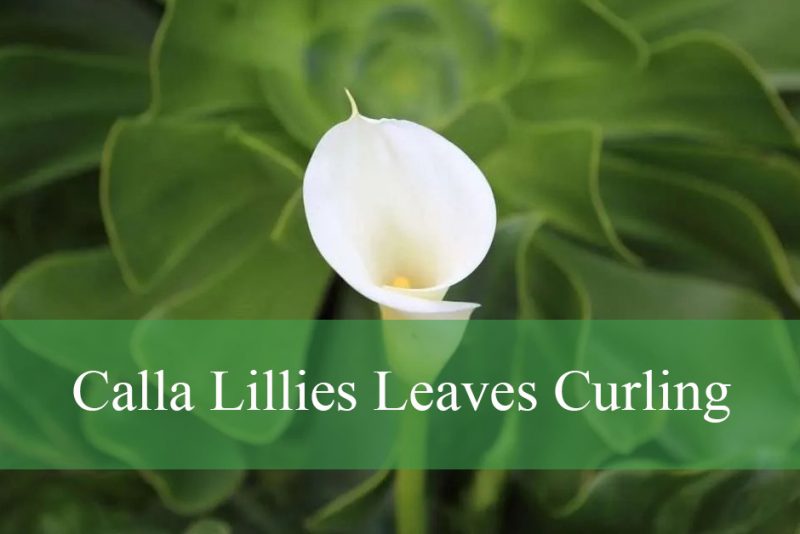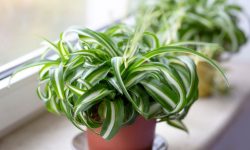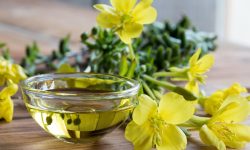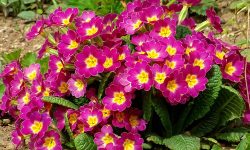Calla lillies are admired worldwide for their elegant trumpet-shaped flowers and lush, vibrant foliage. However, like any plant, they can experience problems, and one common concern among gardeners is when the calla lillies leaves start curling. This curling can be a sign of underlying issues that, if not addressed promptly, may affect the overall health and beauty of your plants.
In this article, we will explore in depth the various causes of calla lillies leaves curling and provide practical solutions to help you restore your plants to their full glory.
Understanding Calla Lillies and Their Leaves

Before diving into the reasons why calla lillies leaves curl, it is important to understand the nature of these plants and their typical leaf characteristics. Calla lillies (Zantedeschia spp.) are tropical plants native to southern Africa. They thrive in warm, moist environments and are often grown both indoors and outdoors for ornamental purposes.
The leaves of calla lillies are generally broad, glossy, and arrow-shaped, forming a striking backdrop to their distinctive flowers. Healthy leaves should appear firm, vibrant green, and smooth, without any signs of distortion or curling. When the leaves begin to curl, it suggests that the plant is experiencing stress or imbalance in its environment.
Common Causes of Calla Lillies Leaves Curling
Several factors can cause calla lillies leaves to curl, ranging from environmental stresses to pests and diseases. Recognizing the underlying cause is the first step toward effective treatment.
1. Watering Issues: Overwatering and Underwatering
One of the most frequent reasons for curling leaves in calla lillies relates to watering problems. Both overwatering and underwatering can cause stress that manifests as leaf curling.
When calla lillies receive too much water, their roots may suffer from lack of oxygen, leading to root rot. This damage impairs the plant’s ability to absorb nutrients and water effectively, causing the leaves to curl as a protective response. Overwatered soil often feels soggy or waterlogged, and the leaves may appear yellowed alongside curling.
On the other hand, underwatering results in dehydration. When the plant does not get enough moisture, its cells lose turgidity, causing the leaves to curl inward to minimize surface area and reduce water loss. The leaves may feel dry, brittle, and even develop brown edges or tips.
2. Temperature Stress
Calla lillies thrive best in moderate temperatures ranging between 60°F to 75°F (15°C to 24°C). Exposure to temperatures outside this range, especially prolonged heat or cold stress, can cause leaf curling.
Excessive heat leads to increased evaporation and water loss, even if the soil remains moist. The plant reacts by curling leaves to reduce exposure to sunlight and conserve moisture. Conversely, cold drafts or sudden temperature drops can damage the leaf tissues, causing curling and discoloration.
3. Light Conditions
Light plays a crucial role in the health of calla lillies. These plants prefer bright, indirect light but can suffer if exposed to harsh direct sunlight or low light conditions.
Too much direct sunlight can cause leaf scorching, resulting in curling and browning at the leaf edges. Conversely, insufficient light can weaken the plant, making the leaves droop and curl as the plant struggles to photosynthesize effectively.
4. Nutrient Deficiencies
Nutrient imbalances often manifest through leaf curling. Calla lillies require a balanced supply of essential nutrients such as nitrogen, potassium, phosphorus, magnesium, and calcium for healthy growth.
A deficiency in potassium, for example, may cause leaf margins to curl and yellow, while insufficient calcium can result in distorted new leaves and curling. Magnesium deficiency often leads to leaf curling accompanied by yellowing between the veins.
5. Pests and Diseases
Insect pests like aphids, spider mites, and thrips frequently attack calla lillies, causing physical damage that leads to leaf curling. These tiny pests feed on the sap, weakening the plant and causing the leaves to twist or curl.
Fungal infections such as powdery mildew or root rot can also cause curling. Root rot caused by pathogenic fungi in overly wet soil severely impacts root health, causing the leaves to curl and wilt.
6. Chemical Damage
Exposure to harmful chemicals, including excessive use of fertilizers, pesticides, or herbicides, can cause chemical burns on the leaves of calla lillies. This damage can lead to curling, discoloration, and necrosis.
Using products at higher than recommended concentrations or spraying during intense sunlight can increase the risk of chemical damage.
Diagnosing the Problem
To effectively treat calla lillies leaves curling, it is vital to carefully examine the plant and its environment to determine the likely cause. Start by inspecting the soil moisture level—feel the top two inches to check for dryness or sogginess. Look for signs of pests on the undersides of leaves or any visible fungal growth.
Note the temperature and light conditions around the plant, and consider recent changes in watering or fertilization routines. Observing the pattern of curling—whether it affects new or old leaves, whether accompanied by discoloration or spots—can also provide clues.
Solutions for Calla Lillies Leaves Curling
Once the cause has been identified, appropriate steps can be taken to remedy the issue. Below are detailed solutions based on the most common causes.
Adjust Watering Practices
If overwatering is the culprit, reduce the watering frequency and improve drainage by ensuring the pot or garden bed has adequate holes or is raised. Remove any standing water and consider repotting the plant in fresh, well-draining soil if root rot has developed.
In case of underwatering, increase watering gradually, making sure the soil remains consistently moist but not soggy. Water deeply so the roots can absorb adequate moisture, especially during warmer months.
Manage Temperature and Light
Protect calla lillies from temperature extremes by moving them to more sheltered locations if grown outdoors or adjusting indoor climate controls. Avoid placing plants near heating vents, air conditioners, or drafty windows.
For light, provide bright but indirect sunlight. If the leaves show signs of sunburn, move the plant to a spot with filtered light. Conversely, if the plant is in a dark area, relocate it to receive more natural light to promote healthy growth.
Fertilize Appropriately
Use a balanced, water-soluble fertilizer formulated for flowering plants to supply necessary nutrients. Follow the recommended dosage and schedule, usually every 4-6 weeks during the growing season.
If a nutrient deficiency is suspected, consider a soil test to determine specific lacking elements. For potassium or magnesium deficiencies, use fertilizers or supplements designed to address these minerals.
Control Pests and Diseases
Treat pest infestations by regularly inspecting the plant and physically removing pests if possible. Use insecticidal soaps or neem oil sprays as natural treatments. For severe infestations, consult with a local garden center for appropriate pesticide recommendations.
Fungal infections may require fungicidal treatments and improved cultural practices such as better air circulation and avoiding overhead watering to keep foliage dry.
Avoid Chemical Damage
Always follow label instructions carefully when using fertilizers, pesticides, or herbicides. Avoid applying these products during the hottest parts of the day or in direct sunlight to prevent leaf burn.
If chemical damage is suspected, rinse affected leaves gently with water to remove residues and reduce stress on the plant.
Preventive Care to Avoid Leaf Curling
Healthy plants are less prone to leaf curling, so adopting good cultural practices can keep your calla lillies thriving.
Choose the right location with proper light and temperature conditions. Use quality, well-draining soil and pots with drainage holes. Maintain a consistent watering schedule that balances moisture without waterlogging.
Regularly fertilize according to plant needs and inspect your plants for early signs of pests or diseases. Prune damaged or curled leaves promptly to encourage new healthy growth.
When to Seek Expert Help
If you have tried the above solutions and your calla lillies leaves continue to curl or worsen, it might be time to consult a professional. Local horticulturists, extension services, or experienced gardeners can provide insights specific to your region and plant conditions.
Sometimes, underlying problems like complex diseases or soil issues require expert diagnosis and treatment beyond basic care.
Frequently Asked Questions (FAQs)
Q1: Why are my calla lillies leaves curling inward?
A1: Curling inward leaves often indicate underwatering or heat stress. The plant curls leaves to reduce water loss. Check soil moisture and adjust watering accordingly.
Q2: Can overwatering cause calla lillies leaves to curl?
A2: Yes, overwatering can lead to root rot, which restricts nutrient uptake and causes leaf curling. Ensure well-draining soil and avoid soggy conditions.
Q3: How does light affect calla lillies leaves curling?
A3: Too much direct sunlight can scorch leaves, causing curling and browning. Insufficient light weakens the plant, leading to drooping and curling. Provide bright, indirect light for best growth.
Q4: What pests cause calla lillies leaves to curl?
A4: Aphids, spider mites, and thrips feed on calla lillies sap, damaging leaves and causing curling. Regular inspection and natural insecticides like neem oil can help control pests.
Q5: How can I prevent calla lillies leaves from curling?
A5: Maintain consistent watering, provide proper light and temperature, fertilize adequately, and monitor for pests and diseases regularly to keep leaves healthy and prevent curling.
Conclusion
Calla lillies leaves curling is a common but manageable issue that signals your plant is under stress. By carefully observing your plants, identifying the cause—be it watering mistakes, temperature fluctuations, light problems, nutrient deficiencies, pests, diseases, or chemical damage—you can apply targeted solutions to restore their health.
With proper care and attention, your calla lillies can once again display their stunning foliage and graceful blooms, adding elegance and charm to your garden or home.






